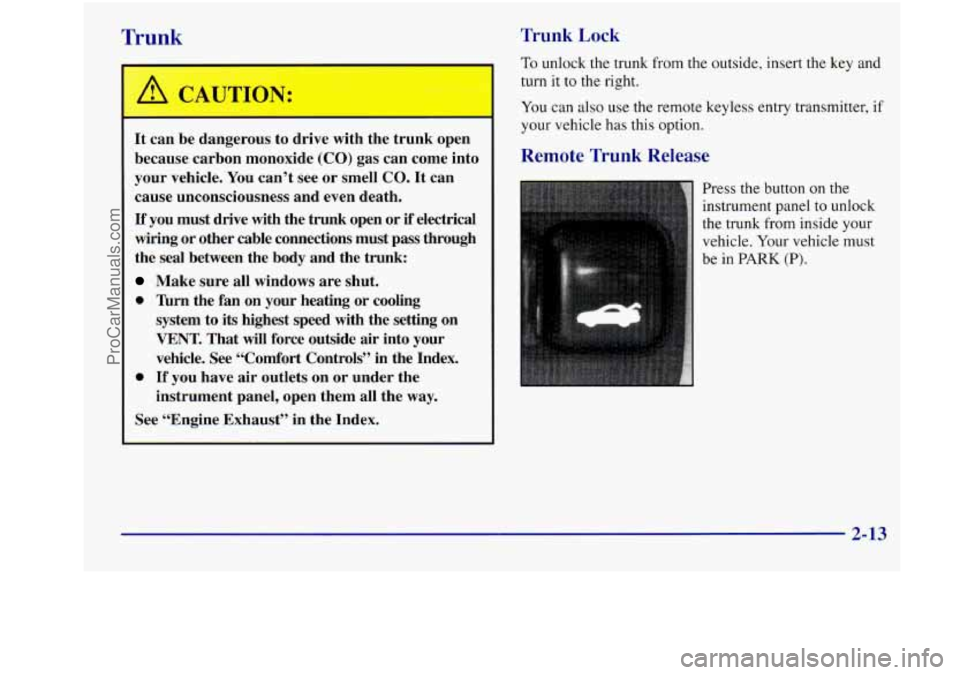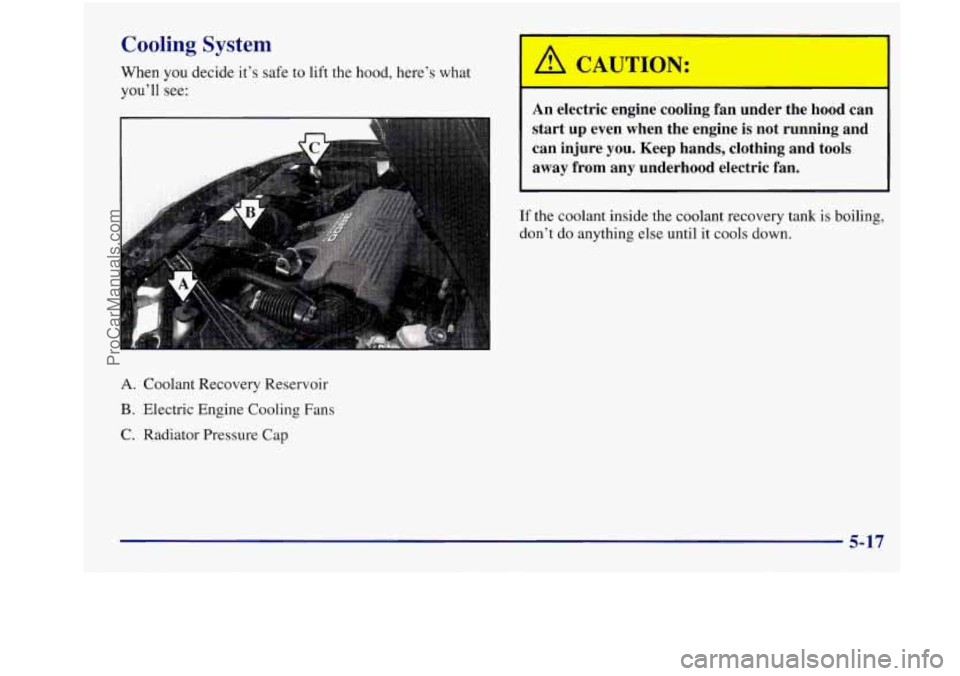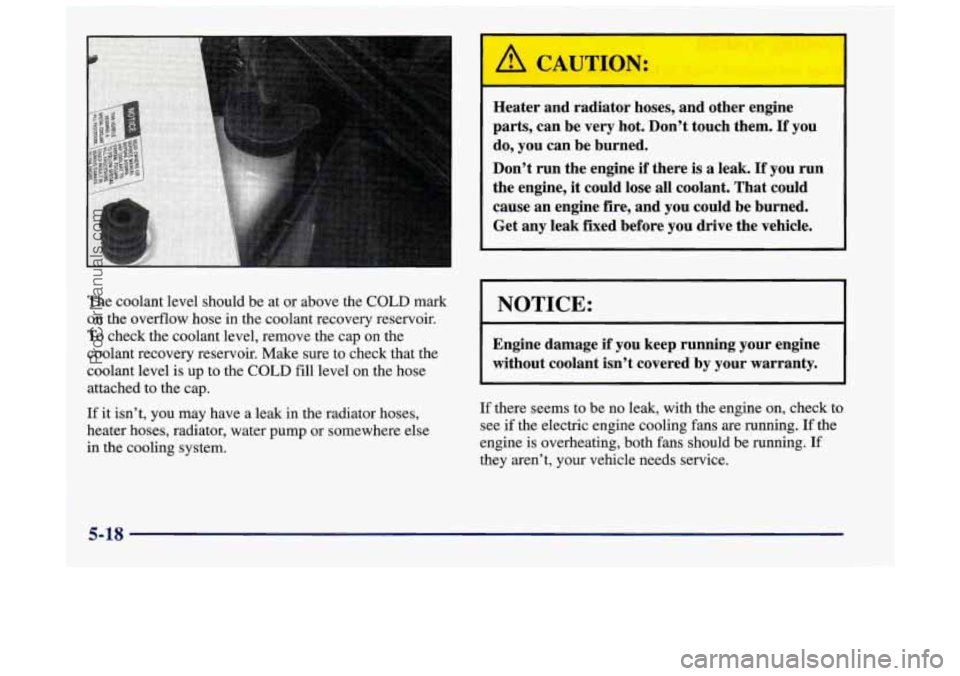cooling OLDSMOBILE INTRIGUE 1998 Owners Manual
[x] Cancel search | Manufacturer: OLDSMOBILE, Model Year: 1998, Model line: INTRIGUE, Model: OLDSMOBILE INTRIGUE 1998Pages: 340, PDF Size: 17.93 MB
Page 73 of 340

Trunk Trunk Lock
It can be dangerous to drive with the trunk open
because carbon monoxide (CO) gas can come into
cause unconsciousness and even death.
If you must drive with the trunk open or if electrical
wiring or other cable connections must pass through
the seal between the body and the trunk:
Make sure all windows are shut.
0 lbrn the fan on your heating or cooling
1 your vehicle. You can’t see or smell CO. It can
system to
its highest speed with the setting on
VENT. That will force outside air into your
vehicle. See
“Comfort Controls” in the Index.
instrument panel, open them all the
way.
0 If you have air outlets on or under the
See “Engine Exhaust” in the Index.
To unlock the trunk from the outside, insert the key and
turn it to the right.
You can also use the remote keyless entry transmitter, if
your vehicle has
this option.
Remote Trunk Release
Press the button on the
instrument panel to unlock
the trunk
from inside your
vehicle. Your vehicle must
2-13
ProCarManuals.com
Page 128 of 340

Comfort Cor: A -01s Temperature Knob
Air Conditioning with Electronic Controls
With this system, you can control the heating, cooling
and ventilation in your vehicle. The system works best if
you keep your windows closed while using it.
Fan Knob
The left knob selects the force of air you want. To turn
the fan off, turn the knob to OFF. The fan must be on to
run the air conditioning compressor.
If the airflow seems very low when the fan knob is turned
to the highest setting, regardless of the mode setting, your
passenger compartment air filter (if equipped) may need
to be replaced. See “Maintenance Schedule” in the Index. The
right knob changes the temperature
of the air
coming through the system. Turn this knob toward red
to
the right for warmer air. Turn it toward blue to the left
for cooler air.
Mode Push Buttons
The upper row of push buttons control the direction of
airflow. For each setting, set the temperature to a
comfortable setting. Each button has an indicator which
will glow when the button is pressed.
-bo
/J VENT: This setting directs air through the
instrument panel outlets.
+’ BI-LEVEL: This setting directs air two ways.
Half of the air is directed through the instrument panel
outlets. Most
of the remaining air is directed through
the floor ducts and a little
to the defrost and side
window vents.
+’ FLOOR: This setting sends most of the air
through the ducts near the floor. The rest comes out
of
the defroster and side window vents.
+@ DEFOG: This setting allows half of the air to go
to the floor ducts and half to the defrost and side
window vents.
+e
e
we
3-2
ProCarManuals.com
Page 129 of 340

DEFROST This setting directs most of the air
through the defrost and side window vents. Some of the
air goes to the floor ducts. The air conditioning
compressor will run automatically in this setting unless
the outside temperature
is below 40°F (4.5"C).
(Even when the compressor is running, you can control
the temperature.)
Air Conditioning Compressor Button
Press the A/C button to operate the air conditioning
compressor. The indicator light on the button will glow
when the button is pressed.
You don't have to press the
button to run the compressor in DEFOG or DEFROST.
Recirculate Button
e This button is used to recirculate much of the air
inside your vehicle. This setting is not available in defrost.
Outside Air Button
This button is used to bring in outside air.
Air Conditioning
On very hot days, open the windows long enough to let
hot inside air escape. This reduces the load on the
compressor, which should help fuel economy.
For quick cool-down on very hot days, use
RECIRCULATE with the temperature knob all the way
in the blue area. If this and the
A/C button pushed
setting is used for long periods of time, the air in your
vehicle may become too dry.
For normal cooling on hot days,
use VENT with the
temperature knob in the blue area. With the A/C button
pushed in and outside air button pushed
in, the system
will bring in outside air and cool it.
On cool but sunny days, the
sun may warm your upper
body, but your lower body may not be warm enough.
You can use BI-LEVEL with the temperature knob in
the middle with the A/C button pushed in and the
outside air button pushed in. The system will bring in
outside air and direct it to your upper
body, while
sending slightly warmed air to your lower body.
You
may notice this temperature difference more at some
times than others.
3-3
ProCarManuals.com
Page 130 of 340

Heating
On cold days use FLOOR and the outside air button
pushed in with the temperature knob all the way in the
red area. The system will bring in outside air, heat it and
send it to the floor ducts.
If your vehicle has an engine coolant heater, you can use
it to help your system provide warm air faster when it’s
cold outside
(0” F (- 18 O C) or lower). An engine coolant
heater warms the coolant your engine and heating
system use to provide heat. See “Engine Coolant
Heater” in the Index.
Ventilation
For mild outside temperatures when little heating or
cooling is needed, use VENT and the outside air button
to direct air through your vehicle. Your vehicle also has
the flow-through ventilation system described later in
this section.
Defogging and Defrosting
Your system has two settings for clearing the front and
side windows. To defrost the windows quickly,
use
DEFROST with the temperature knob all the way in the
red area. To warm passengers while keeping the
windows clean, use DEFOG.
Air Conditioning with Automatic and
Auxiliarv Temnerature Control
With this system, you set a temperature. You can then
either let the system adjust airflow and force to maintain
the temperature,
or you can manually adjust the flow
and force. The system works best if you keep your
windows closed while using
it.
3-4
ProCarManuals.com
Page 131 of 340

Driver Temperature Knob Auto Button
The left
(DRIVER) knob sets the temperature for the
entire system when the right (PASS) knob is in the
center or neutral position. Turn the DRIVER knob
toward red
to the right to raise the temperature. Turn it
toward blue to the left
to lower the temperature. The
display will show your selection for a few seconds,
then
the outside temperature will show. If you push the knob
the set temperature will again be displayed for
a few
seconds, then the outside temperature will show.
Passenger Temperature Knob
The right (PASS) knob
adjusts the air temperature
on the passenger's side
so
it is warmer or cooler than
the temperature set by
the driver.
Turn the PASS knob toward red to the right to raise the
temperature. Turn it toward blue to the left to lower the
temperature. The passenger temperature will not be
shown in the display. For
the most efficient operation you should press the
AUTO button and set the system temperature.
The system will select the best fan speed and airflow
settings to keep you comfortable. The air conditioning
compressor will run if the outside temperature is
above 40°F (4.5"C). You may notice a delay
of three to four minutes before the fan comes on.
Off Button
Push the OFF button to turn the system off. The display
will show OFF and outside temperature. The system will
continue to automatically control air temperature to the
last set temperature.
Manual Control
If you prefer to manually control the heating, cooling
and ventilation
in your vehicle, set the system to the
temperature and fan speed you want. Next, push the
desired airflow direction pushbutton. The system will
try to maintain the temperature you set using the mode
you select. The following suggestions will help the
system run more efficiently in manual mode.
3-5
ProCarManuals.com
Page 133 of 340

Air Conditioning Heating
On very hot days, open the windows long enough to let
hot, inside air escape. This reduces the time the
compressor has to run, which should help fuel economy.
For quick cool-down on very hot days, use FECIRC.
If this setting is used for long periods of time, the air in
your vehicle may become too dry.
For normal cooling on hot days, use UPPER with the
A/C button pushed in. The system will bring in outside
air and cool it.
On cool but sunny days, the sun may warm your upper
body, but your lower body may not be warm enough.
You can use BI-LEV with the A/C button pushed in.
The system will bring in outside air and direct it to your
upper body, while sending slightly warmed air to your
lower body. You may notice this temperature difference
more at some times than others. On
cold days use LOWER. The system will bring in
outside air, heat it and send it to the floor ducts.
If your vehicle has an engine coolant heater, you can use
it to help your system provide warm air faster when it’s
cold outside (0°F
(-18°C) or lower). An engine coolant
heater warms the coolant your engine and heating
system use to provide heat. See “Engine Coolant
Heater” in the Index.
Ventilation
For mild outside temperatures when little heating or
cooling is needed, use UPPER to direct outside air
through your vehicle. Your vehicle also has the
flow-through ventilation system described later in
this section.
Defogging and Defrosting
Your system has two settings for clearing the front and
side windows.
To defrost the windows quickly, use DEE
To warm passengers while keeping the windows clean,
use DEFOG.
3-7
ProCarManuals.com
Page 178 of 340

If you drive regularly in steep country, or if you’re
planning to visit there, here are some tips that can make
your trips safer and more enjoyable.
Keep your vehicle in good shape. Check all fluid
levels and also the brakes, tires, cooling system
and transaxle. These parts can work hard on
mountain roads.
Know how to go down hills. The most important
thing to know is this: let your engine do some of the
slowing down. Shift to
a lower gear when you go
down a steep or long hill.
1
If you don’t shift down, your brakes could
get
so hot that they wouldn’t work well. You
would then have poor braking or even none going
down
a hill. You could crash. Shift down to let
your engine assist your brakes on
a steep
downhill slope. Coasting downhill in NEUTRAL
(N) or with
the ignition off is dangerous. Your brakes will
have to do all the work
of slowing down. They
could get
so hot that they wouldn’t work well.
You would then have poor braking
or even none
going down
a hill. You could crash. Always have
your engine running and your vehicle in gear
when you go downhill.
Know how to go uphill. You may want to shift down
to a lower gear. The lower gears help cool your engine
and transaxle, and you can climb the hill better.
0 Stay in your own lane when driving on two-lane
roads in hills or mountains. Don’t swing wide or cut
across the center of the road. Drive at speeds that let
you stay in your own lane.
0 As you go over the top of a hill, be alert. There could be
something in your lane, like a stalled car or an accident.
0 You may see highway signs on mountains that warn of
special problems. Examples are long grades, passing or
no-passing zones, a falling rocks area or winding
roads. Be alert to these and take appropriate action.
4-24
ProCarManuals.com
Page 191 of 340

When You Are Ready to Leave After
Parking on a Hill
1. Apply your regular brakes and hold the pedal down
while you:
Start your engine;
Shift into a gear; and
Release the parking brake.
2. Let up on the brake pedal.
3. Drive slowly until the trailer is clear of the chocks.
4. Stop and have someone pick up and store the chocks.
Maintenance When Trailer Towing
Your vehicle will need service more often when you’re
pulling a trailer. See the Maintenance Schedule for more
on this. Things that are especially important in trailer
operation are automatic transaxle fluid (don’t overfill),
engine oil, drive belts, cooling system and brake
adjustment. Each of these
is covered in this manual,
and the Index will help you find them quickly. If you’re
trailering, it’s a good idea to review this information
before you start your trip.
Check periodically to see that all hitch nuts and bolts
are tight.
Engine Cooling When Trailer Towing
Your cooling system may temporarily overheat during
severe operating conditions. See “Engine Overheating”
in the Index.
4-37
ProCarManuals.com
Page 209 of 340

Cooling System
When you decide it’s safe to lift the hood, here’s what
you’ll see:
A. Coolant Recovery Reservoir
B. Electric Engine Cooling Fans
C. Radiator Pressure Cap
I A CAUTION:
An electric engine cooling fan under the hood can
start up even when the engine is not running and can injure you. Keep hands, clothing and tools
away from any underhood electric fan.
If the coolant inside the coolant recovery tank is boiling,
don’t do anything else until
it cools down.
5-17
ProCarManuals.com
Page 210 of 340

The coolant level should be at or above the GOLD mark
on the overflow hose in the coolant recovery reservoir.
To check the coolant level, remove the cap on the
coolant recovery reservoir.
Make sure to check that the
coolant level
is up to the COLD fill level on the hose
attached
to the cap.
If it isn’t, you my have a leak in the radiator hoses,
heater hoses, radiator, water pump or somewhere else
in the COO& system.
Heater and radiator hoses, and other engine
parts, can be very hot. Don’t touch them.
If you
do, you can be burned.
Don’t run the engine
if there is a leak. If you run
the engine,
it could lose all coolant. That could
cause an engine fire, and you could be burned.
Get any leak fixed before you drive the vehicle.
I NOTICE:
r
Engine damage if you keep running your engine
without coolant isn’t covered
by your warranty.
If there seems to be no leak, with the engine on, check to
see
if the electric engine cooling fans are running. If the
engine is overheating, both
fans should be running. If
they aren’t, your vehicle needs service.
5-18
ProCarManuals.com